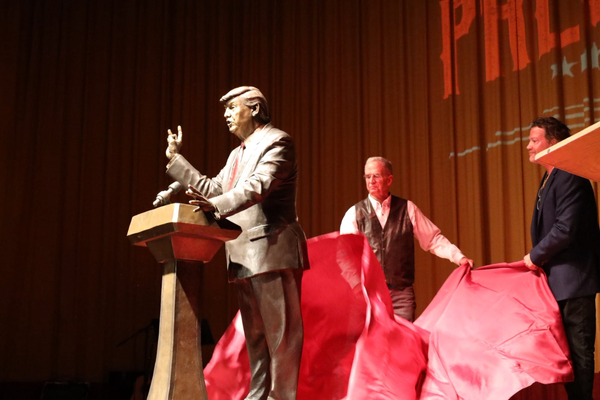
SAKAIDE, Kagawa -- Anyone looking to visit Iwakuro Island by car, or even a boat, will be unable to get there. They will have to take the elevator.
The elevator that descends to the island in Sakaide, Kagawa Prefecture is located near a bus stop on the Seto Ohashi bridge.
Bridge piers are visible from anywhere on the tiny island's 1.4 kilometer circumference on the Seto Inland Sea.

Upon exiting the elevator visitors are greeted by a tranquil rural setting, worlds apart from the high-speed traffic on the bridge.
Only 1 entrance

The Iwakurojima bus stop sits about halfway along the 9.4-kilometer long Seto Ohashi, about 60 meters above the sea. When I got off the bus in mid-September, I was welcomed by a pleasant sea breeze.
From the glass-walled elevator I could see the spiral loop that connects the bridge above to the ground below. This was installed when the bridge opened in 1988 at the strong request of the island's residents and is only used by the locals and emergency vehicles. Tourists and other visitors must use the elevator.
The bridge's piers stand on five islands, but only Iwakuro Island can be reached by an elevator.

Looking up at the bridge from the island gives you a sense of its immense size. Seto Ohashi is the general name for the multiple bridges. The elevator is sandwiched between Hitsuishijima Bridge on the Honshu side and Iwakurojima Bridge on the Shikoku side.
Both are 792-meter-long "cable-stayed bridges," which use cables stretched from towers to support girders. Architecture enthusiasts appreciate their left-right symmetry for looking like the wings of a swan.
Noise from trains on the bridge can be heard on the island.
"Thirty years have passed since the bridge opened. Maybe I'm losing my hearing but I don't mind the noise anymore," said Kojiro Nakamura, 72, a fisherman who lives on the island.
Pioneering history
Iwakuro Island was uninhabited before being settled in 1797. The island's high-quality clay helped generate a prosperous tile-making industry that operated from the Edo period (1603-1867) to around the Taisho era (1912-1926). At its peak there were seven kilns on the island.
Now the main industry is fishing. The idyllic fishing village has a population of 64 in 30 households. "The whole island is like a family," Nakamura said.
On my visit, locals were moving between each other's homes, with stray cats napping in alleyways. There are no convenience stores or restaurants on the island, and only three inns.
One of them is called Iwamoto, run by 65-year-old Misuzu Iwamoto.
"Only guests who want to enjoy a leisurely time fishing come," she said, though recently young people carrying cameras have been coming to see "elevator island."
Huge mural
In October, a giant mural was completed at Iwakuro Junior High School, the only school on the island.
Before the bridge was built, the island was home to many Cryptotympana facialis -- a species of cicada known as kumazemi -- whose noise is capable of drowning out conversations.
Half a century ago, Iwakuro Junior High School students studied the ecology of kumazemi for three years, and were awarded first prize at the Japan Students Science Awards for their work. Ever since, the kumazemi has been a symbol of the island. When the bridge was built, a kumazemi image was painted on the foundation of one of the piers. After the bridge was completed, the kumazemi population dropped.
Aging and a decrease in the island's population has left Iwakuro Junior High School with only one second-year female student. With the school in danger of closing down, teachers and residents worked together to make Iwakuro known as "kumazemi island" by painting a mural 15 meters in length on the school's gymnasium wall that faces Seto Ohashi.
Principal Shingo Kawasaki, 58, said, "The mural reaffirms the islanders' love of the island and I hope it'll encourage outsiders to become interested in the island."
-- How to get there
The Iwakurojima bus stop is about 20 minutes from JR Kojima Station in Kurashiki, Okayama Prefecture, on a Shimotsui Dentetsu (Shimoden) bus on the Seto Ohashi Line.
From the Shikoku side, take a Kotosan bus from JR Sakaide Station, then change to a Shimoden bus at the Yoshima PA bus stop. The trip takes about 50 minutes.
It takes about 20 minutes to walk around the island. Spots to visit include the Daitengu shrine, which has red komainu lion-dogs made from the island's soil, and the Kurohama beach, which has black sand that is rich in iron sand.
-- Extend your trip!
Seto Ohashi hall
The Seto Ohashi Commemorative Hall is a memorial hall that served as a pavilion for the Seto Ohashi commemorative exposition held in 1988. The hall opened after the exposition in November of that year.
Exhibits in the four-story building show the chronology of the bridge's construction, photos and models of how it was built. There is also a "bridge theater" where visitors can enjoy panoramic images and an observation deck that gives an up-close view of the bridge.
Read more from The Japan News at https://japannews.yomiuri.co.jp/







